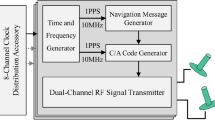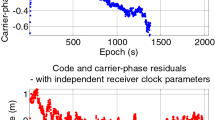Abstract
The widespread use of global navigation satellite system (GNSS) receiver in mobile devices induces the adoption of effective GNSS-based indoor positioning algorithms exploiting low-cost hardware. In a previous study, we proposed a new architecture for indoor positioning system to estimate the user position by utilizing the pseudoranges from the smartphone-embedded GNSS module. The advantages of such a system are low cost and low requirements in terms of hardware-level modification for end users. However, all end users and most application developers do not have permission to read the pseudoranges from the embedded GNSS modules. Instead of pseudoranges, the user positions are easily obtained from the GNSS module in any mobile device. Thus, we further improve our positioning algorithm based on the position obtained from the embedded GNSS module rather than the pseudoranges. This position does not correspond to the true one since the indoor signal is non-line-of-sight. Thus, it is named the pseudo-position. The key to the improved algorithm is that the distances from the user terminal to the indoor transmitting antennas are calculated using the differences between the position of the outside antenna and the pseudo-position. The algorithm is tested using a simulated GNSS-based indoor positioning system which is implemented on a GNSS software receiver. The simulation results show that the indoor positioning system is able to provide horizontal positioning with meter-level accuracy in both static and dynamic situations. Additionally, the proposed method improves the robustness of the indoor positioning system to the non-synchronization measurements.















Similar content being viewed by others
References
Chen LH, Wu EHK, Jin MH, Chen GH (2014) Intelligent fusion of Wi-Fi and inertial sensor-based positioning systems for indoor pedestrian navigation. IEEE Sens J 14(11):4034–4042. doi:10.1109/JSEN.2014.2330573
Collin J, Mezentsev O, Lachapelle G (2003) Indoor positioning system using accelerometry and high accuracy heading sensors. In: Proceedings ION-GPS/GNSS-2003, Institute of Navigation, Portland, OR, USA, Sept 9–12, pp 1–7
Giammarini M, Isidori D, Concettoni E, Cristalli C, Fioravanti M, Pieralisi M (2015) Design of Wireless Sensor Network for Real-Time Structural Health Monitoring. In: Proceedings of IEEE-DDECS-2015, IEEE, Belgrade, Serbia, Apr 22–24, 2015, pp 107–110
Gundegard D, Akram A, Fowler S, Ahmad H (2013) Cellular positioning using fingerprinting based on observed time differences. In: Proceedings of IEEE-SaCoNeT-2013, vol 1, IEEE, Paris, France, June 17–19, 2013, pp 1–5
Lee S, Koo B, Jin M, Park C, Lee MJ, Kim S (2014) Range-free indoor positioning system using smartphone with Bluetooth capability. In: Proceedings of IEEE/ION-PLANS-2014, IEEE, Monterey, CA, USA, May 5–8, 2014, pp 657–662
Liang JZ, Corso N, Turner E, Zakhor A (2013) Image Based Localization in Indoor Environments. In: Proceedings of COM Geo-2013, IEEE, San Jose, CA, USA, July 22–24, 2013, pp 70–75
Lin T, Ma M, Broumandan A, Lachapelle G (2013) Demonstration of a high sensitivity GNSS software receiver for indoor positioning. Adv Space Res 51(6):1035–1045. doi:10.1016/j.asr.2012.06.011
Liu HH, Lo WH, Tseng CC, Shin HY (2014) A WiFi-based weighted screening method for indoor positioning systems. Wirel Pers Commun 79(1):611–627. doi:10.1007/s11277-014-1876-y
Mautz R (2009) Overview of current indoor positioning systems. Geod Cartogr 35:18–22
Nirjon S, Liu J, Priyantha B, DeJean G (2013) High-sensitivity cloud-offloaded instant GPS for indoor environments. In: Proceedings of ACM-SenSys-2013, ACM Press, New York, USA, Roma, Italy, Nov 11–15, 2013, pp 1–2
Ozsoy K, Bozkurt A, Tekin I (2013) Indoor positioning based on global positioning system signals. Microw Opt Technol Lett 55(5):1091–1097. doi:10.1002/mop.27520
Sundaramurthy MC, Chayapathy SN, Kumar A, Akopian D (2011) Wi-Fi assistance to SUPL-based Assisted-GPS simulators for indoor positioning. In: Proceedings of IEEE-CCNC-2011, IEEE, Las Vegas, NV, USA, Jan 8–11, 2011, pp 918–922
Wang Y, Li H, Luo X, Sun Q, Liu J (2014) A 3D fingerprinting positioning method based on cellular networks. Int J Distrib Sens Netw 2014:1–8. doi:10.1155/2014/248981
Wang J, Hu A, Liu C, Li X (2015) A floor-map-aided WiFi/pseudo-odometry integration algorithm for an indoor positioning system. Sensors 15(4):7096–7124. doi:10.3390/s150407096
Werner M, Kessel M, Marouane C (2011) Indoor positioning using smartphone camera. In: Proceedings of IPIN-2011, IEEE, Guimaraes, Portugal, Sept 21–23, 2011, pp 1–6
Xu R, Chen W, Xu Y, Ji SY (2015) A new indoor positioning system architecture using gps signals. Sensors 15(5):10074–10087. doi:10.3390/s150510074
Shafiee M, O’Keefe K, Lachapelle G (2012) OFDM Symbol timing acquisition for collaborative WLAN-based assisted GPS in weak signal environments. In: Proceedings of ION-GNSS-2012, Institute of Navigation, Nashville, TN, USA, Sept 18–21, pp 1–13
Zandbergen PA, Barbeau SJ (2011) Positional accuracy of assisted GPS data from high-sensitivity GPS-enabled mobile phones. J Navig 64(03):381–399. doi:10.1017/S0373463311000051
Acknowledgements
The research was funded by a Hong Kong Research Grants Council (RGC) Competitive Earmarked Research Grant (PolyU 152023/14E) and a research fund from the Research Institute for Sustainable Urban Development, Hong Kong Polytechnic University.
Author information
Authors and Affiliations
Corresponding author
Rights and permissions
About this article
Cite this article
Xu, R., Chen, W., Xu, Y. et al. Improved GNSS-based indoor positioning algorithm for mobile devices. GPS Solut 21, 1721–1733 (2017). https://doi.org/10.1007/s10291-017-0647-0
Received:
Accepted:
Published:
Issue Date:
DOI: https://doi.org/10.1007/s10291-017-0647-0




